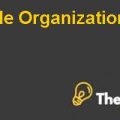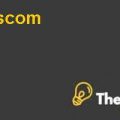
MEAD CORPORATION: COST OF CAPITAL Case Solution
Percentage of Different Capitals Used in the Company:
In order to compute the weighted average cost of capital for the company, the first and the foremost task is to assign weights to the different capital available with the company. It can be seen from the capital structure of the company that the company is a pure levered company and that it includes portion of debt obligations as well as the equity portion in its overall capital. Since debt is the cheaper source of finance because it is the tax deductible source therefore, it lowers the overall cost of capital. By including the appropriate amount of debt capital, the company can be able to provide the required rate of return for its shareholders and could undertake various investment projects with the given hurdle rate.
For the assigning of weights to different capitals, the book value method is used. With the help of this method, the weights are assigned by using the formulas as given below:
- For the Weight of Shareholder Capital = Equity Capital / (Equity + Debt)
- For the Weight of Debt Capital = (1 – Weight of Equity)
Assigning the book values to the weights of each of the two capital providers is relatively very easy method as compared to the use of market values or the targeted values. By using this method, the weights of the two different capital providers are readily available from the balance sheet of the Mead Corporation. The balance sheet of the company reveals that the shareholder’s contribution in the overall capital in the year 1990 is $ 1531.1 million. On the other hand the long term debt portion in the overall capital is $ 1256.60 million.
By putting these values in the formula, it can be seen that the company is using approximately 55% of its overall capital from the equity shareholders, whereas the remaining 45% are coming from the debt obligation which would be further used in the overall computation of cost of capital for the company.
Cost of Debt
In order to compute the cost of Debt for the company this would further be used in the computation of the overall weighted average cost of capital. The value of the market yield to maturity would be taken from data provided for the long term bonds issued by the company and which are rated as “A” by Moody’s. In addition to this, the tax rate which would be used for the last quarter would be similar to that of the last quarter for the computation purpose.
The formula used for the overall calculation of cost of debt is given as below:
Cost of Debt = Debt Rate * (1 – Tax Rate)
From the case, the debt rate is taken to be 9.80% whereas the latter portion of the formula is 62%. With the help of these values, the cost of debt of the company is computed to about 6.3% which would be utilized in the computation of cost of capital.
Risk Free Rate
In order to compute the risk free rate which would be utilized in the computation of cost of equity capital for the company in the most widely used financing model, Capital Asset Pricing Model. The empirical studies have shown that a number of analysts tend to use the long term Treasury rate or the short term Treasury rate as the risk free rate in their computation of cost of equity..................
This is just a sample partial case solution. Please place the order on the website to order your own originally done case solution.













